vasia
Member 
Posts: 1,655 
|
Post by vasia on Jan 1, 2014 15:24:01 GMT
January 1, 1931

Postal stationery envelope from Tsementniy Zavod "Proletariy" (the "Proletarian" cement factory ) in Novorossiysk, Chernomorskaya (in the Black Sea) to Frankfurt (8/1) and re-directed to Eschborn on the same day, with receiving cancels from both. Franked correctly at 35k. The registration label is of the standard “R” type in black from Novorossisk, supplemented by hand to indicate dispatch from “cim zawod”. See below a photo of the cement factory. Addressed to the G. Schiele engineering works and iron foundry company (producing fans and blowers for mining and foundries).
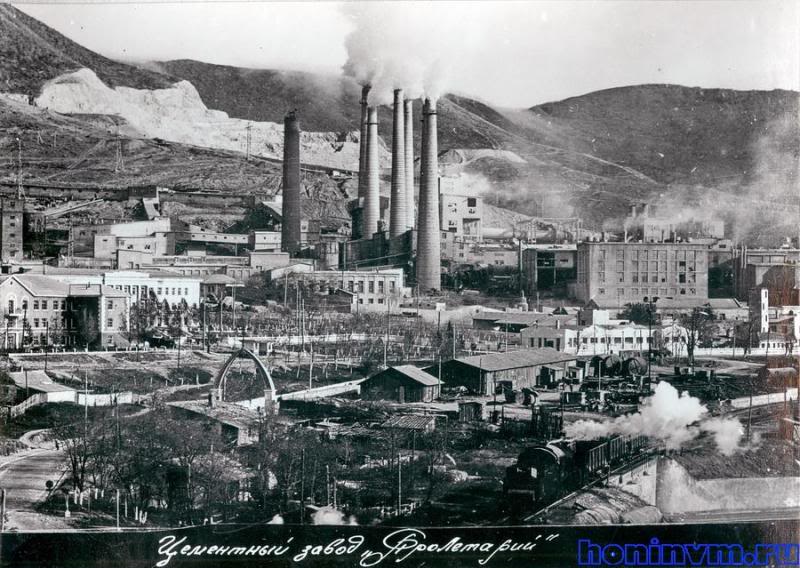
|
|
rod222
Member 
Posts: 11,055  What I collect: Worldwide Stamps, Ephemera and Catalogues
What I collect: Worldwide Stamps, Ephemera and Catalogues
|
Post by rod222 on Jan 1, 2014 20:20:53 GMT
"Mrs. Delia Darling Honey
That is one, jolly nice name to be blessed with.
|
|
tomiseksj
Moderator  Woodbridge, Virginia, USA
Woodbridge, Virginia, USA
Posts: 6,385  What I collect: Worldwide stamps/covers, Cinderellas, Ohio Prepaid Sales Tax Receipts, U.S. WWII Ration ephemera
What I collect: Worldwide stamps/covers, Cinderellas, Ohio Prepaid Sales Tax Receipts, U.S. WWII Ration ephemera
|
Post by tomiseksj on Jan 1, 2014 21:24:33 GMT
"Mrs. Delia Darling Honey That is one, jolly nice name to be blessed with. Born a darling and a honey by marriage...she must have been a real sweetheart!  |
|
alanl
Departed
Rest in Peace
Abbotsford, B.C., CANADA.
Posts: 1,670 
|
Post by alanl on Jan 1, 2014 23:59:06 GMT
January 1, 1977. The postal code seems to indicate Vancouver.  |
|
tomiseksj
Moderator  Woodbridge, Virginia, USA
Woodbridge, Virginia, USA
Posts: 6,385  What I collect: Worldwide stamps/covers, Cinderellas, Ohio Prepaid Sales Tax Receipts, U.S. WWII Ration ephemera
What I collect: Worldwide stamps/covers, Cinderellas, Ohio Prepaid Sales Tax Receipts, U.S. WWII Ration ephemera
|
Post by tomiseksj on Jan 2, 2014 13:51:41 GMT
January 2Stamped envelope (buff, diagonally laid paper) with 3c red Washington indicia (Scott U10; 1854) postmarked in Dover, New Hampshire. 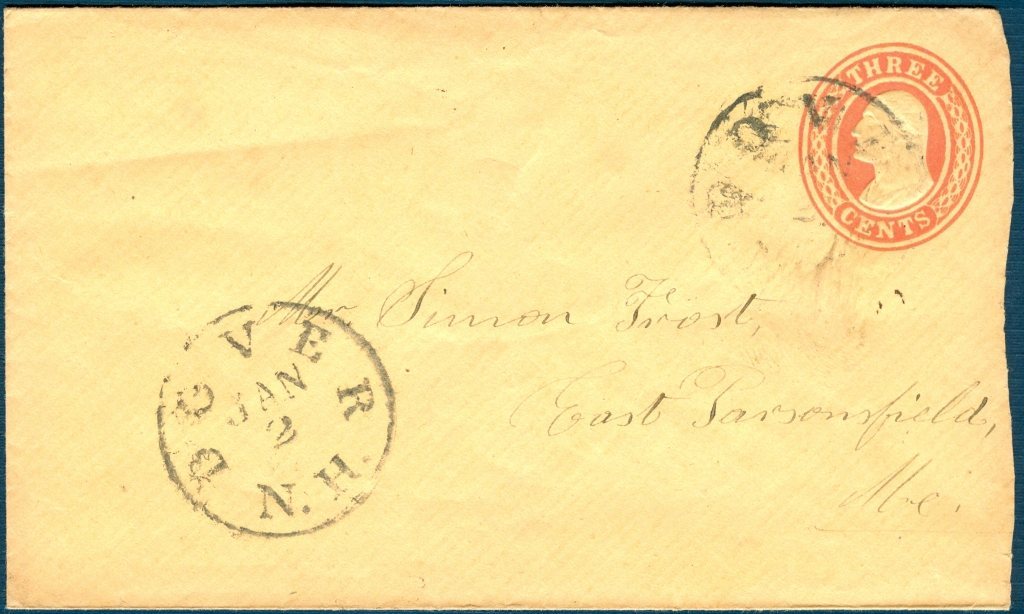
|
|
rod222
Member 
Posts: 11,055  What I collect: Worldwide Stamps, Ephemera and Catalogues
What I collect: Worldwide Stamps, Ephemera and Catalogues
|
Post by rod222 on Jan 2, 2014 14:01:26 GMT
(buff, diagonally laid paper)
Never struck that before. That must be linked to a particular US paper maker surely.
|
|
tomiseksj
Moderator  Woodbridge, Virginia, USA
Woodbridge, Virginia, USA
Posts: 6,385  What I collect: Worldwide stamps/covers, Cinderellas, Ohio Prepaid Sales Tax Receipts, U.S. WWII Ration ephemera
What I collect: Worldwide stamps/covers, Cinderellas, Ohio Prepaid Sales Tax Receipts, U.S. WWII Ration ephemera
|
Post by tomiseksj on Jan 2, 2014 14:35:50 GMT
(buff, diagonally laid paper) Never struck that before. That must be linked to a particular US paper maker surely. I'm not sure if it was tied to a single paper maker. Stamped envelopes were first issued on July 1, 1853 in the U.S. and George F. Nesbitt & Co. was the sole producer during the 1853 to 1870 period. Envelopes have been supplied in a variety of colors but, in the early years, buff and white were the primary colors. Laid paper (vertical, horizontal and diagonal) was used almost exclusively from 1853 to 1915 with some exceptions. Since 1915, wove paper has been the rule. |
|
|
|
tomiseksj
Moderator  Woodbridge, Virginia, USA
Woodbridge, Virginia, USA
Posts: 6,385  What I collect: Worldwide stamps/covers, Cinderellas, Ohio Prepaid Sales Tax Receipts, U.S. WWII Ration ephemera
What I collect: Worldwide stamps/covers, Cinderellas, Ohio Prepaid Sales Tax Receipts, U.S. WWII Ration ephemera
|
Post by tomiseksj on Jan 2, 2014 15:40:41 GMT
January 2, 1918
...It is highly possible that the card was written by a Czech POW (notice the language)... A great addition to the calendar thread; however, at least one of our members is unable to read the text. Would you please translate the portion of the text that led you to believe that a Czech POW may have written the card? |
|
vasia
Member 
Posts: 1,655 
|
Post by vasia on Jan 2, 2014 17:23:17 GMT
Hello, Steve
I am sorry, maybe I was imprecise in my wording. I cannot read the text of the card. It seems to me, however, that the language might be Czech. It is definitely not Russian or German. At that point in time, there were tens of thousands of Czech POW's in semi-free status all over revolutionary Russia, so I was making a guess regarding the possible sender of the card.
|
|
tomiseksj
Moderator  Woodbridge, Virginia, USA
Woodbridge, Virginia, USA
Posts: 6,385  What I collect: Worldwide stamps/covers, Cinderellas, Ohio Prepaid Sales Tax Receipts, U.S. WWII Ration ephemera
What I collect: Worldwide stamps/covers, Cinderellas, Ohio Prepaid Sales Tax Receipts, U.S. WWII Ration ephemera
|
Post by tomiseksj on Jan 2, 2014 17:33:01 GMT
Vasia, Thanks for clarifying. I tried entering a few of the words in Google translate but got nowhere. Perhaps one of our members can tell us what the card says.
|
|
Zuzu
Member  Inactive
Self-Proclaimed Black Belt in Google Fu
Inactive
Self-Proclaimed Black Belt in Google Fu
Posts: 768 
|
Post by Zuzu on Jan 2, 2014 19:51:41 GMT
I think it's Czech or Slovak... I was able to make out a couple of the words on the card and get something through Google Translate. For example, the end of the first line of the body of text looks like "zdravim a dekuji", which translates as "Greetings and thank you" or "Hello and thank you". I think I figured something about a blanket... hard to make out the writing on the card. :/
|
|
rod222
Member 
Posts: 11,055  What I collect: Worldwide Stamps, Ephemera and Catalogues
What I collect: Worldwide Stamps, Ephemera and Catalogues
|
Post by rod222 on Jan 2, 2014 22:38:11 GMT
"I'm not sure if it was tied to a single paper maker. "
Thanks Steve, you are a wealth of knowledge.
I find it hard to believe paper makers would have screens straight AND diagonal in format,
perhaps they cut the paper differently.
I am happy to let this go, not wanting to grab hold of the slippery pole
that is stamp paper.
|
|
alanl
Departed
Rest in Peace
Abbotsford, B.C., CANADA.
Posts: 1,670 
|
Post by alanl on Jan 3, 2014 0:10:44 GMT
January 2 in Bournemouth-Poole, England. That`s a mouthful.  |
|
therealwesty
Member  Inactive
Sorting my Small Queens
Inactive
Sorting my Small Queens
Posts: 331 
|
Post by therealwesty on Jan 3, 2014 2:56:16 GMT
Rod, regarding the diagonal weave on the cover paper; I have a theory. I think the paper would originally be laid with a horizontal or vertical weave. If you imagine the cover unfolded, you would start with a rectangle of paper. Fold the corners in, with a bit of glue/gum in all the right places and you make a cover. BUT if you consider how the paper orientation changes, this would account for the diagonal laid lines. I am thinking the sheet of paper would be laid out to appear as a diamond, then once the corners are folded in you have the rectangular cover. The sheet of paper would be laid, rectangles cut, then folded... the change in orientation would create the diagonal lines on the finished product.
|
|
tomiseksj
Moderator  Woodbridge, Virginia, USA
Woodbridge, Virginia, USA
Posts: 6,385  What I collect: Worldwide stamps/covers, Cinderellas, Ohio Prepaid Sales Tax Receipts, U.S. WWII Ration ephemera
What I collect: Worldwide stamps/covers, Cinderellas, Ohio Prepaid Sales Tax Receipts, U.S. WWII Ration ephemera
|
Post by tomiseksj on Jan 3, 2014 3:50:34 GMT
This definition from the glossary on AskPhil leads me to believe that the orientation of the lines was likely production-related.
Diagonally laid paper: where wires, used in the papermaking process, are laid diagonally across the paper.
|
|
rod222
Member 
Posts: 11,055  What I collect: Worldwide Stamps, Ephemera and Catalogues
What I collect: Worldwide Stamps, Ephemera and Catalogues
|
Post by rod222 on Jan 3, 2014 6:10:26 GMT
Rod, regarding the diagonal weave on the cover paper; I have a theory. I think the paper would originally be laid with a horizontal or vertical weave. If you imagine the cover unfolded, you would start with a rectangle of paper. Fold the corners in, with a bit of glue/gum in all the right places and you make a cover. BUT if you consider how the paper orientation changes, this would account for the diagonal laid lines. I am thinking the sheet of paper would be laid out to appear as a diamond, then once the corners are folded in you have the rectangular cover. The sheet of paper would be laid, rectangles cut, then folded... the change in orientation would create the diagonal lines on the finished product. That is an interesting hypothesis, and worthy of consideration, yet the "paper" has the diag orientation, not the cover. To me this suggests the paper making screen was placed diagonally in the frame. All entirely guesswork on my part. Steve's later post clouds the issue, suggesting the wire was laid on the paper, I always assumed the paper was in slurry form, and the wire came from below, creating the weave orientation. |
|
vasia
Member 
Posts: 1,655 
|
Post by vasia on Jan 3, 2014 8:02:23 GMT
I think it's Czech or Slovak... I was able to make out a couple of the words on the card and get something through Google Translate. For example, the end of the first line of the body of text looks like "zdravim a dekuji", which translates as "Greetings and thank you" or "Hello and thank you". I think I figured something about a blanket... hard to make out the writing on the card. :/ Thank you Zuzu for attempting to decipher the content.  I take the chance to make a slight correction to my write-up: the card was addressed to the small town of Drasov in Brno district. |
|
I.L.S.
Departed
Rest in Peace
I am in Clearfield, Pa. I love US Classic covers!
Posts: 2,113 
|
Post by I.L.S. on Jan 3, 2014 11:14:01 GMT
January 3rd 1904 buff. Boonsboro MD.I have no idea as of yet what the watermark and type the postal stationery is though?

|
|
Zuzu
Member  Inactive
Self-Proclaimed Black Belt in Google Fu
Inactive
Self-Proclaimed Black Belt in Google Fu
Posts: 768 
|
Post by Zuzu on Jan 3, 2014 14:53:15 GMT
January 3rd 1904buff. Boonsboro O.{hio} I wonder if it's not Boonsboro, MD? I really need to do some "real" work today, but I did come up with this Henderson family biography that may or may not give you some information about the Misses.  |
|
vasia
Member 
Posts: 1,655 
|
Post by vasia on Jan 3, 2014 16:26:02 GMT
January 3, 1924

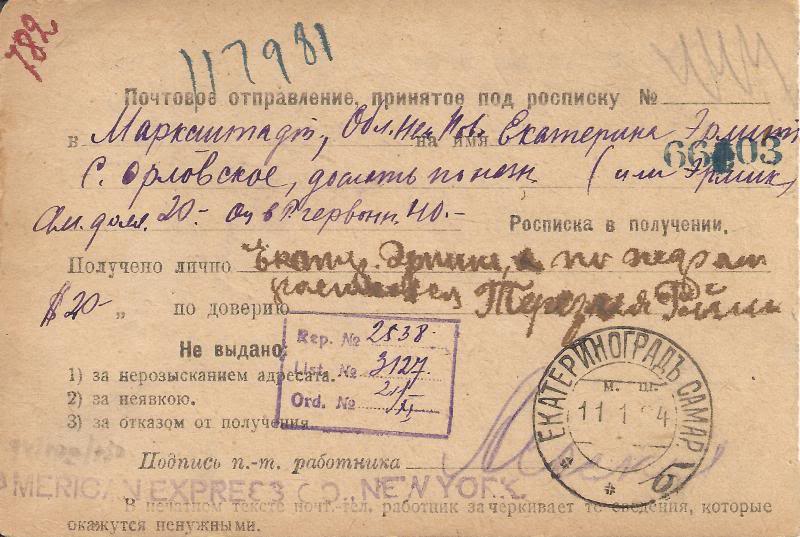
A Notification-of-Receipt card posted in Moscow and addressed to Ekaterinograd, Samara province. The monetary equivalent of $20 is paid out on 11/1 and the card is returned registered on 14/1, reaching Moscow on the 19th. Franked at the appropriate N.o.R rate of 12k (i.e registered letter rate) with a vertical gutter pair. The provisional label is a blue-border insured-letter one of Ekaterinograd-on-Volga, presumably due to the lack of regular registration labels.
Ekaterinograd is in the Volga German area – on the back there is a manuscript reference to “Marxstaadt", its new name, as well as the inscription “Obl.Nem.Pov.” (=Volga German oblast, i.e prior to its elevation into an Autonomous Soviet Socialist Republic - ASSR in December 1924). Four years into the renaming of the city, the old imperial-period postmarks are still in use.
These cards were used to notify individuals of the receipt of a monetary sum from abroad. The recipient in Russia received (from the local bank branch) the monetary equivalent in rubles, signed the card and retained a stub attached to the left side of the card. The main part of the card was then returned to the central bank offices in Moscow and then shipped in batches to the corresponding foreign bank as proof that the money had been transferred.
During Soviet times they can be found in use from April 1922 until late 1929. They were franked at a concessionary rate of one-way letter rate or one-way registered letter rate (if registration was required). The franking and payment were done at the time of the original dispatch of these cards from the central bank offices, but the receiving post-office applied the necessary postmarks and registration labels prior to returning the card.
|
|
alanl
Departed
Rest in Peace
Abbotsford, B.C., CANADA.
Posts: 1,670 
|
Post by alanl on Jan 4, 2014 0:01:34 GMT
It`s January 3rd in Alida, Sask. and Prince Rupert, B.C.   |
|
|
|
Post by stampgeezer on Jan 4, 2014 5:20:07 GMT
Jan. 4th, 1933. Registered cover from and to my favorite philatelic city, Yakima, Wa.


|
|
Ryan
Moderator  Calgary, Alberta, Canada
Calgary, Alberta, Canada
Posts: 2,753  What I collect: If I have a catalogue for it, I collect it. And I have many catalogues ....
What I collect: If I have a catalogue for it, I collect it. And I have many catalogues ....
|
Post by Ryan on Jan 4, 2014 5:55:02 GMT
It`s January 3rd in Alida, Sask. and Prince Rupert, B.C. I have an aunt who lives in Prince Rupert - rainiest city in Canada, cloudiest city in Canada, coldest summers of any city in Canada, etc etc. But the winters are relatively mild, especially considering the very short days, and there must be something in all that rain that does you some good. She's 96 and she looks like she's barely 70! Ryan |
|
rod222
Member 
Posts: 11,055  What I collect: Worldwide Stamps, Ephemera and Catalogues
What I collect: Worldwide Stamps, Ephemera and Catalogues
|
Post by rod222 on Jan 4, 2014 6:56:36 GMT
"Jan. 4th, 1933. Registered cover from and to my favorite philatelic city, Yakima, Wa."
Any idea why the usage of Mute Cancels on your cover front?
|
|
alanl
Departed
Rest in Peace
Abbotsford, B.C., CANADA.
Posts: 1,670 
|
Post by alanl on Jan 4, 2014 7:28:42 GMT
Back in the murky past my father and uncles and both grandfathers would
put-put their gillnet fish boats up the coast to `Rupert and fish the
Skeena river for salmon.
I visited Prince Rupert in 1973. It was like driving in the bottom
side of a cloud. Heavy rain. The sun came out the next day and
I had a nice visit.
|
|
|
|
alanl
Departed
Rest in Peace
Abbotsford, B.C., CANADA.
Posts: 1,670 
|
Post by alanl on Jan 5, 2014 0:04:38 GMT
January 4th at Haywards Heath, England.  |
|
tomiseksj
Moderator  Woodbridge, Virginia, USA
Woodbridge, Virginia, USA
Posts: 6,385  What I collect: Worldwide stamps/covers, Cinderellas, Ohio Prepaid Sales Tax Receipts, U.S. WWII Ration ephemera
What I collect: Worldwide stamps/covers, Cinderellas, Ohio Prepaid Sales Tax Receipts, U.S. WWII Ration ephemera
|
Post by tomiseksj on Jan 5, 2014 14:27:17 GMT
January 5
This cover bearing a 3c violet, perf. 11X10.5 stamp commemorating the 125th anniversary of the first steamship ( SS Savannah) to cross the Atlantic (Scott 923, issued May 22, 1944) was postmarked in Saint Louis, Missouri on this date in 1945. 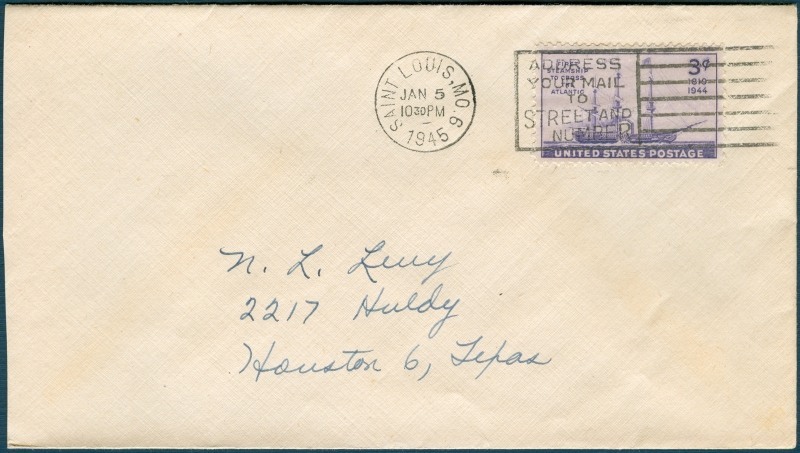
|
|
vasia
Member 
Posts: 1,655 
|
Post by vasia on Jan 5, 2014 16:40:32 GMT
January 5, 1926
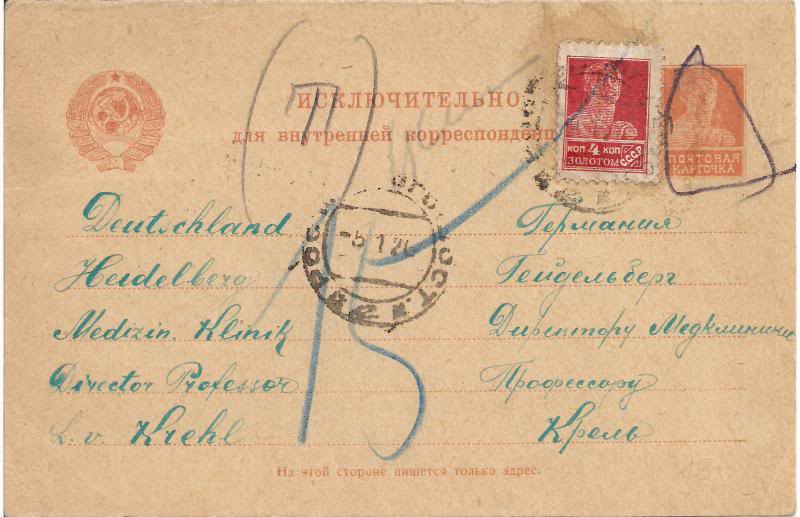
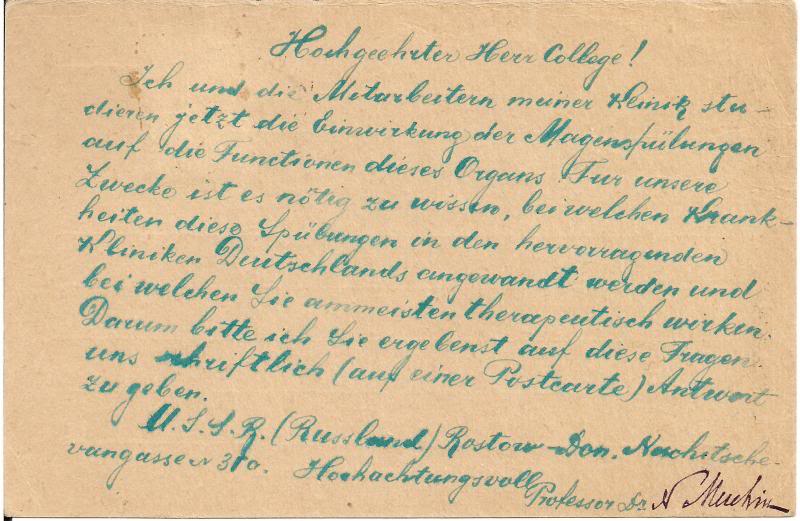
The first, non-denominated, Soviet postal card, issued December 1923 exclusively for domestic use, used here from Rostov-on-Don to Heidelberg, Germany. The "3k" indicium (prevailing domestic postcard rate of the period) is supplemented with a 4k worker “small head” for the 7k international rate. However, the sender has disregarded the exclusive domestic use of this postal card, mentioned clearly at its top heading. The illegal international use of the postcard is marked by circling the card indicium and with the handwritten “T”. A postage-due charge of “15” is written by pen, presumably in Germany. The card is addressed to a well-known physiologist Ludolf von Krehl, professor at the University of Heidelberg, by a colleague.
|
|